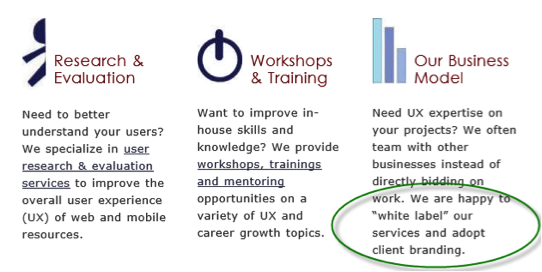While “white-labeling” has been associated most commonly with limited-edition musical recordings, it has also come to refer to a situation where a product or service is provided to a company and that company then sells that product or service under their own brand. For a UX freelancer, this means simultaneously maintaining a personal identity as a freelancer, while adopting the appearance of that prime contractor’s brand to an end-client in order to sub-contract a project. This could, for example, require the use of the prime contractor’s email system when emailing the end-client and perhaps even involve prime contractor-branded business cards at meetings.
Many UX freelancers hesitate to “white-label” their services, fearing that the lack of direct recognition from an end-client will have a negative impact on their ability to advance their career. Yet there are a number of advantages to being that man or woman behind the curtain helping other companies provide services they’d otherwise be unable to offer (either at all or in a scalable fashion).
For the past six years, I’ve opened myself up fully to a system that, while being available for direct client work, also effectively allows for white-labeling. During this time, a large portion of my work has involved representing a design, development, or user research agency and supplying skills that either in-house staff didn’t have or skills that required more resources than the company had available in-house. To emphasize my openness to white-labeling my services, I even updated my website home page text to tell potential clients just that: “We are happy to ‘white-label’ our services and adopt client branding.”
Simply put, my willingness to white-label allows for a greater work pipeline. I look for interesting projects that match my existing UX skillset, have a timeline that is feasible with other projects that I may have taken on, and a pay-rate within my range. These steps provide a necessary set of parameters that define whether I can take on a project. Limiting to how a client wishes to present me to an end client provides an unnecessary additional constraint.
Over the years, I’ve averaged over 30 hours of billable project work per week this way, sometimes working simultaneously on completely unrelated projects. In the weeks prior to writing this, for example, I worked on white-labeled web and mobile projects related to two Federal agencies, a bank, a war memorial, two non-profits, and the quality of medical care.
Addressing the Arguments Against White-Labeling
Here are some of the things I commonly hear criticizing white-labeling:
“You’re limiting your exposure”
Exposure to lots of people is critical to freelance success and freelancers might be afraid to white-label because they think this will limit their necessary exposure. I believe very much in the value of exposure to others for UX career success. To that end, I’ve written articles on how UX organizations can be leveraged in meeting others, why networking with other UXers is so critical, and the concept of “UX Adventure,”—unpaid efforts that, among other things, are exciting opportunities for exposure. The point is, direct exposure doesn’t need to come from work, particularly if, like me, white-labeling is a common and easy path to securing interesting projects.
There are a number of advantages to being that man or woman behind the curtain
In addition to all of the project work I’m doing as a freelancer, each week, I typically put in many additional hours of non-project time. Considering that a majority of my work involves white-labeled efforts, my target market is primarily those who are also involved in the UX space (either directly or tangentially). For that reason, my extra time is centered on that direct/tangential-UX market and can be spent writing UX-related blog posts or articles, speaking at or attending UX events, getting involved in organizational leadership, meeting with colleagues, and social media activities (where I am often using a #UX hash tag).
“White-labeling won’t build your portfolio”
I’ve heard freelancers say that if they white-label, they lose the ability to include the projects in their UX project portfolio. For me, a portfolio typically means deliverables related to UX research or evaluation or strategy efforts: materials that I produced that led up to the effort, actual outputs, and the supplemental description of work activities around those efforts. White-labeling does not mean that you lose the ability to add items to your portfolio. On the contrary, you often gain a greater variety of projects to discuss. Whether white-labeling or working directly for an end-client, I almost always have non-disclosure agreements that have varying levels of rigidity in what is okay to do or not do.
In cases where it is safe to do so without violating any agreements, I’ve taken a few of these deliverables and made them generic, removing anything that was confidential and making sure that what I was evaluating would be totally unidentifiable. Sometimes I’ve had to remove blocks of text or images, and I put in a placeholder block indicating that something was removed for confidentiality purposes. When I’ve shown these anonymized samples, I have never had a potential client complain about not getting to see the un-scrubbed version. When I do have deliverables that are so confidential that even anonymizing them wouldn’t be appropriate, I don’t include them in my portfolio—but this is certainly the less common scenario.
In addition, unless your client has any issue with you listing them on your LinkedIn profile or resume, you can list the name of your client. The way I do this on my LinkedIn profile when I shouldn’t tie the listing to the end client is with something like:
- Role Title + “(via Lebsontech)”
- CLIENT NAME
- Generic Description such as: “Stakeholder and user interviews, contextual inquiries and usability tests for CLIENT NAME’s Clients”
In some cases, if the prime client does not have a problem with me detailing who the end-client is, I’ll certainly include the name of the end client as well.
“You’re forbidden from letting them know you exist.”
In her article “The Silent Subcontractor,” Laura Kalbag discusses her problem with contractors that hide their subcontractors from the end-client entirely. In some cases, I’ve happily been hired as a “behind the scenes” mentor to client staff where I’ve had the opportunity to monitor, evaluate, and provide feedback on staff performance to help improve internal staff skills. For example, for one project, I first walked through the usability testing process with a recently designated moderator to acquaint him with the process. Once he was comfortable with this process, he began to conduct his first few remote testing sessions. He would follow the script and I would jot down some feedback to relay to him at the conclusion of the session. In a few instances over the course of the sessions, when there was something very important that he needed to ask or probe about, I’d send him an immediate note with some real-time feedback.
Not only did I function as the “silent subcontractor” to the customer, I was also working to help make the client’s staff so effective that I was writing myself out of future usability testing efforts. It did not seem useful or appropriate to think along these lines, however. This is, after all what the client wanted and I felt really good about helping someone to advance his skills. Increasing staff skills could also mean that this client would be more likely to bid on efforts that involved usability testing where they could still use me either as a mentor for other staff or as someone to handle overflow.
“You don’t even get to be part of the project pitch”
Freelancers have told me that that they find it inappropriate for a client to pitch the project first and then once the project scope has been defined, bring in the white-labeled freelancer. From my perspective, as long as the client has the appropriate knowledge to pitch the project, this isn’t a problem. While I’m always happy to help a client improve their pitch to the end client, it’s also fine if they choose not to involve me until after the pitch has been accepted. While there have been occasional times when I’ve turned down a project because I am uncomfortable with the way it was scoped, for the most part, I’ve found that it’s usually possible to shape and scale my efforts appropriately to what a client has pitched.
“You’re working so someone else can get a cut”
Freelancers may not appreciate someone else getting a cut of the project revenue. However, I’d gladly have others getting a cut of the revenue in exchange for skipping or at least short-cutting the often laborious and time consuming process of writing multiple proposals in an attempt to win at least some of the project work. This means less time spent on bidding overhead, and more time spent on billable work and secondarily, more time for those exposure-related activities.
I’ve done a lot of work in the government space, and I’ve heard stories from other contractors about the hurdles that they needed to go through to bid on a project and subsequently get paid. For this type of client, sometimes there is as a requirement to be on what is known as the “GSA Schedule,” a lengthy process that unfurls before anyone even gets to bid on a particular set of projects. Sometimes, there are other designations that are also required along with requisite paperwork.
Similarly, in the world of large corporations, there are often detailed paperwork and rigid requirements with the bids, the contracts, and eventual payment. Being one step removed from all this can provide a reduction in efforts related to the contract and any resulting headaches from having to jump through these hoops.
“White-labeling is dishonest”
I’ve heard freelancers say that white-labeling is not honest and that it is unethical to be representing a company when they are not actually regular employees of the company. I do not believe that there is anything unethical or inappropriate about the concept of white-labeling. Staff augmentation for a period of time or for a specific project is a valid, understood, and acceptable form of doing business. Of course, I do not want anything said about me by the prime that is explicitly dishonest. My “true” unfiltered profile is very visible via a quick Internet search, so while I don’t know how much an end-client would care, should they hear my name and choose to Google me, they would not see anything that conflicts with what they were led to believe by my client. As long as that is the case, I am perfectly happy to white-label my services, use a prime client’s branding, email addresses or business cards, and refer to myself as part of a team.
Consider White-Labeling Your UX Skills
Hopefully, I’ve made the case that you can comfortably white-label and enjoy the benefits of a wider portfolio of exciting projects realizing that there is nothing dishonest about this approach. But if I’ve failed and if you are still totally unconvinced about the career value or ethics of white-labeling, that’s okay—there will be less competition for those of us who are willing to take this path to successful UX freelancing.
Image of blank records courtesy Shutterstock.








